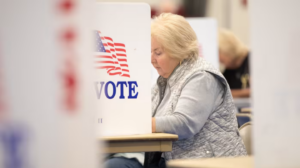Older Women Voters Hold the Power in the US Midterms
Women over 50 often complain that western society treats them as invisible — not to mention irrelevant. But according to new polling from AARP, the leading US organisation for people 50 and over, older women could hold the balance of power in next month’s hugely consequential midterm elections.
An AARP survey of likely women voters aged 50 and over, published earlier this month, found that just over half weren’t sure yet who to vote for — though a whopping 94 per cent planned to cast a ballot. Older women normally decide by springtime how to vote, says Nancy LeaMond, AARP executive vice-president and chief advocacy and engagement officer. She says it is “startling” to find such a large proportion undecided so close to the poll.
I know how they feel: my own absentee ballot sits waiting on my kitchen counter. I haven’t filled it out yet, because I haven’t yet been able to rise sufficiently above my general disdain for all politicians to choose any one of them over another. The vacillation of people like me could make a big difference to the upcoming midterms, which could shift the distribution of power in the US Congress, and transform state legislatures across the country, says LeaMond. Early voting in some states has already begun.
The Center for American Women and Politics at Rutgers University calculates that women have cast 10mn more votes than men in recent elections, and AARP says women over 50 punch particularly above their weight. Using census and state voter file data, AARP calculates that women over 50 cast nearly a third of ballots in both 2020 and 2018, while constituting little more than a quarter of registered voters. In 2020, 83 per cent of registered women voters in this age group cast a ballot.
“We are a very big group, there are 63mn of us, and older women have been especially important for the last few elections,” LeaMond says. She adds: “In some of the key swing states like Arizona, Florida, Wisconsin and Michigan, women over 50 are 25 to 28 per cent of the population but 31 to 35 per cent of voters . . . they are almost equally divided between Democrats and Republicans . . . and many of these races are so close that people have to pay attention to a group that says they are definitely going to the polls.”
Why is this group so uncertain? Christine Matthews, president of Bellwether Research and Consulting, one of the pollsters who partnered with AARP on the survey, says “there are quite a few cross pressures on these voters: they are weighing all sorts of different things from concern about inflation to threats to social security, as well as threats to democracy and concern about crime and immigration”. Jackie Salit, president of Independent Voting, says she thinks older women may be undecided partly because “the political culture is so distasteful that they tune it out”.
